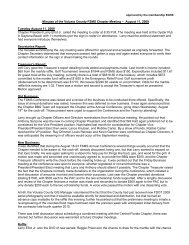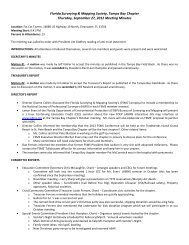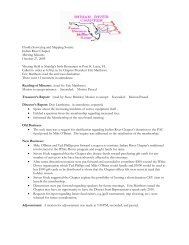July 2012 - FSMS
July 2012 - FSMS
July 2012 - FSMS
Create successful ePaper yourself
Turn your PDF publications into a flip-book with our unique Google optimized e-Paper software.
Three Sanitation Workers<br />
and One Policeman Die<br />
in an Underground Sewage<br />
Pumping Station in<br />
Kentucky<br />
Introduction:<br />
The National Institute for<br />
Occupational Safety and<br />
Health (NIOSH), Division<br />
of Safety Research<br />
(DSR), is currently conducting<br />
the Fatal Accident<br />
Circumstances and Epidemiology<br />
(FACE) Project,<br />
which-is focusing<br />
primarily upon selected<br />
electrical-related and confined<br />
space-related fatalities,<br />
by scientifically collecting data from a sample of<br />
fatal accidents, it will be possible to identify and rank<br />
factors that influence the risk of fatal injuries for selected<br />
employees.<br />
On <strong>July</strong> 5, 1985, one police officer and two sewer workers<br />
died in an attempt to rescue a third sewer worker,<br />
who had been overcome by sewer gas at the bottom of<br />
an underground pumping station. All four persons were<br />
pronounced dead upon removal from the station.<br />
Contacts/Activities:<br />
Officials of the Occupational Safety and Health Program<br />
for the State of Kentucky notified DSR concerning this<br />
fatality and requested technical assistance. This case<br />
has been included in the FACE Project. On <strong>July</strong> 15,<br />
1985, the DSR research team (an industrial hygienist, an<br />
epidemiologist, an occupational-health nurse, and a<br />
safety specialist) conducted a site visit, met with an employer<br />
representative, interviewed comparison workers,<br />
discussed the incident with the Kentucky OSHA Compliance<br />
Officer, and photographed the accident site.<br />
Synopsis of Events:<br />
On <strong>July</strong> 5, 1985, at approximately 10:00 a.m. two sewer<br />
workers (27 and 28 years of age) entered a 50-foot deep<br />
underground pumping station. The station is one of<br />
twelve that pumps sewage to the city's waste water<br />
treatment plant. The workers entered through a metal<br />
shaft 3-feet in diameter) on a fixed ladder that lead to an<br />
underground room (8'x8'x7'). The ventilating fan was not<br />
functioning. Neither worker was wearing personal protective<br />
clothing or equipment.<br />
The two workers proceeded to remove the bolts of an<br />
inspection plate from a check valve. The plate blew off<br />
allowing raw sewage to flood the chamber, overwhelming<br />
one of the workers. The second worker exited the<br />
pumping station and radioed the police department requesting<br />
assistance.<br />
He again entered the<br />
station and was also<br />
overcome. Two police<br />
officers responded to<br />
the call at approximately<br />
10:09 a.m. and<br />
one officer entered the<br />
pumping station. Later<br />
the sewage systems<br />
field manager arrived<br />
on the scene and followed<br />
the officer into<br />
the pumping station.<br />
None of the rescuers<br />
returned to the top of<br />
the ladder. A construction<br />
worker, who was<br />
passing by the site,<br />
stopped and entered the station in a rescue attempt.<br />
After descending approximately 10 feet into the shaft, he<br />
called for help. The second police officer assisted the<br />
construction worker out of the shaft. None of the responding<br />
men wore respirators.<br />
Photo by milksva<br />
Fire department personnel arrived at the accident site at<br />
approximately 10:11 a.m. One fireman, wearing a selfcontained<br />
breathing apparatus (SCBA), entered the<br />
shaft, but could not locate the four men. By this time<br />
sewage had completely flooded the underground room.<br />
The fireman exited the pumping station. A second volunteer<br />
fireman (“WS", 240 lbs.) entered the shaft wearing a<br />
SCBA and a life line. As he began his descent he apparently<br />
slipped from the ladder and became wedged in the<br />
shaft approximately 20 feet down. (His body was folded<br />
with his head and feet facing upward.) Not being able to<br />
breathe, he removed the face mask and lost consciousness.<br />
Rescuers at the site extricated the fireman after a<br />
30 minute effort. No further rescue attempts were made,<br />
until professional divers entered the station and removed<br />
the bodies. Autopsy results revealed a considerable<br />
amount of sewage in the lungs of the sewer workers<br />
and only a trace of sewage in the lungs of the field<br />
manager and the police officer.<br />
Recommendations/Discussion:<br />
Recommendation #1: Employers should develop proper<br />
work procedures and should adequately train employees<br />
to maintain and repair the sewage system. This training<br />
should include recognition of potential hazards associated<br />
with failures within those systems.<br />
Discussion: The sewer workers did not have an understanding<br />
of the pumping station's design; therefore, mechanical<br />
failures and hazards associated with those failures<br />
were not adequately identified. Records were not<br />
kept of mechanical failures or repairs. The sewer workers<br />
"believed' that a malfunctioning valve had previously<br />
The Florida Surveyor <strong>July</strong> <strong>2012</strong> 25














